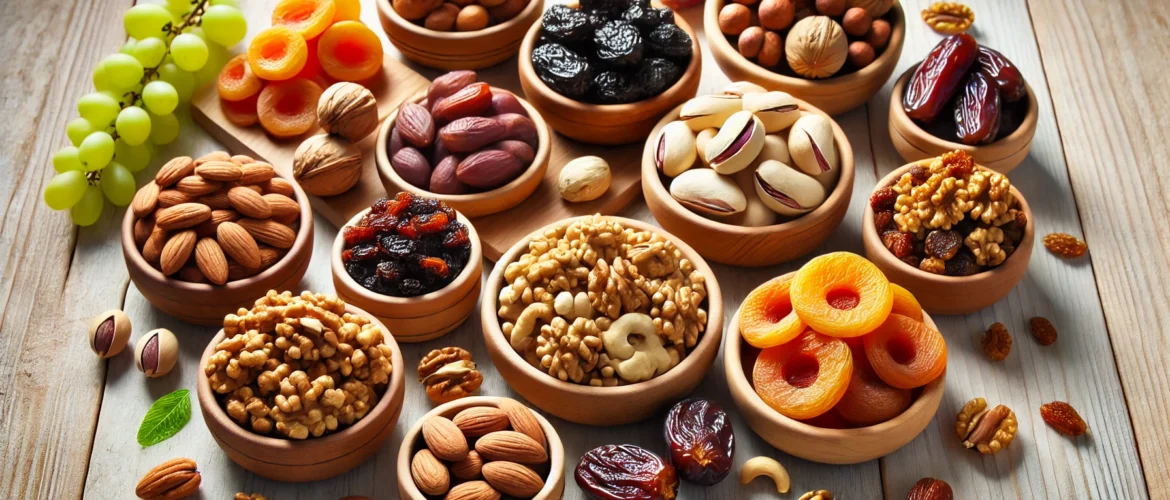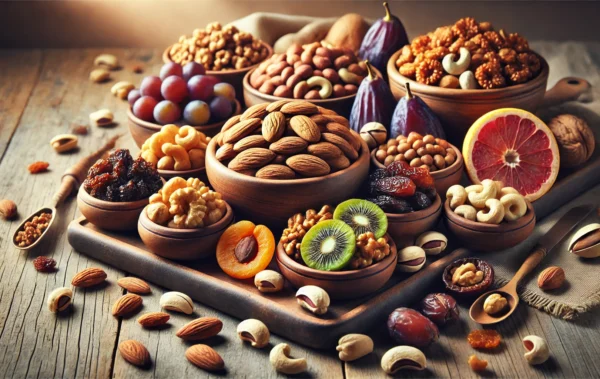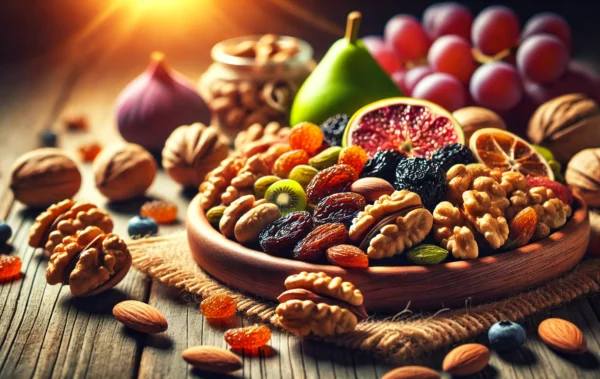No products in the cart.

Understanding the Calorie Content of Different Dry Fruits
Introduction
Dry fruits are a popular and convenient snack, packed with essential nutrients and offering numerous health benefits. However, understanding the calorie content of different dry fruits is crucial, especially for those who are mindful of their calorie intake. In this article, we will explore the calorie content of various dry fruits, helping you make informed decisions about incorporating them into your diet.
What Are Dry Fruits?
Dry fruits are fruits from which the majority of the natural water content has been removed through drying methods such as sun drying or using dehydrators. This process concentrates the fruit’s nutrients, making dry fruits a rich source of vitamins, minerals, and fiber. Common types of dry fruits include almonds, walnuts, cashews, raisins, and dried apricots.
It’s important to differentiate between naturally dried fruits and those that undergo additional processing. Some commercially available dried fruits may contain added sugars and preservatives, which can impact their nutritional value and calorie content.
Nutritional Value of Dry Fruits
Dry fruits are nutritional powerhouses, offering a wide range of health benefits. They are generally high in dietary fiber, which aids in digestion, and are packed with essential vitamins and minerals such as potassium, magnesium, iron, and calcium. Additionally, dry fruits are a good source of antioxidants, which help protect the body from oxidative stress and inflammation.
Despite their small size, dry fruits are calorie-dense, meaning they provide a significant amount of energy in a small serving. This makes them an excellent snack for those needing a quick energy boost, but it also means that portion control is important, especially for those watching their calorie intake.
Why Calorie Content Matters
Understanding the calorie content of dry fruits is essential for managing your overall diet and maintaining a healthy weight. Calories are a measure of the energy that food provides, and consuming more calories than your body needs can lead to weight gain. While dry fruits are nutritious, they are also calorie-dense, meaning that even small portions can add up quickly in terms of calorie intake.
Different dry fruits have varying calorie contents, influenced by their natural sugar content, fat levels, and the degree of drying they have undergone. Being aware of these differences can help you make informed choices, especially if you are counting calories or trying to lose weight.
Detailed Calorie Content of Popular Dry Fruits
Here is a breakdown of the calorie content for some of the most popular dry fruits. The values are based on a standard serving size of 1 ounce (28 grams):
Almonds
Almonds are one of the most popular dry fruits, known for their crunchy texture and mild flavor. They contain approximately 160-170 calories per ounce. Almonds are also rich in healthy fats, protein, and fiber, making them a filling and nutritious snack.
Walnuts
Walnuts are slightly higher in calories, with around 185-190 calories per ounce. They are an excellent source of omega-3 fatty acids, which are beneficial for heart health. Walnuts also provide protein and fiber, contributing to a feeling of fullness.
Cashews
Cashews have a creamy texture and a rich flavor, with about 155-160 calories per ounce. They are lower in fiber compared to almonds and walnuts but are still a good source of healthy fats and protein. Cashews also contain important minerals like magnesium and iron.
Pistachios
Pistachios are slightly lower in calories than other nuts, with approximately 150-160 calories per ounce. They are rich in antioxidants, including lutein and zeaxanthin, which are important for eye health. Pistachios are also a good source of protein and fiber.
Raisins
Raisins, which are dried grapes, contain about 85-90 calories per ounce. They are high in natural sugars, which contribute to their calorie content. Raisins are also a good source of iron and potassium, and they provide a quick source of energy.
Dried Apricots
Dried apricots contain roughly 70-75 calories per ounce. They are high in vitamins A and C and are a good source of dietary fiber. Dried apricots are also lower in sugar compared to raisins, making them a slightly less calorie-dense option.
Dates
Dates are among the highest in calories, with around 200-210 calories per ounce. They are very sweet and are often used as a natural sweetener in recipes. Dates are also rich in fiber, potassium, and antioxidants, making them a nutrient-dense choice despite their high calorie content.
Figs
Dried figs contain about 70-75 calories per ounce. They are high in dietary fiber and are a good source of calcium and potassium. Figs have a sweet, chewy texture and can be a satisfying snack, but like other dried fruits, portion control is key due to their calorie density.
Comparing Calorie Content: Dry Fruits vs Fresh Fruits
One of the key differences between dry fruits and fresh fruits is their calorie content. The drying process removes water from the fruit, concentrating the natural sugars and increasing the calorie content per serving. For example, fresh grapes have far fewer calories per ounce compared to raisins. This concentration of calories is why it's important to be mindful of portion sizes when consuming dry fruits.
In addition to the higher calorie content, dried fruits can also have a higher concentration of certain nutrients. However, they may also contain added sugars or preservatives, which can further increase their calorie count and reduce their overall nutritional value. When choosing between fresh and dried fruits, it's essential to consider these factors and opt for natural, unsweetened versions whenever possible.
How to Incorporate Dry Fruits into Your Diet
Dry fruits are versatile and can be easily incorporated into your diet in various ways. Whether you're looking for a quick snack, a nutritious breakfast addition, or a way to enhance your meals, dry fruits can fit into many dietary patterns. Here are some ideas on how to include them in your daily routine:
- Snacking: Enjoy a small handful of mixed nuts or dried fruits as a mid-morning or afternoon snack. Pair them with yogurt or cheese for added protein.
- Breakfast: Add dried fruits like raisins, apricots, or dates to your oatmeal, cereal, or smoothie bowls for natural sweetness and extra nutrients.
- Baking: Use dry fruits in baking recipes like muffins, breads, and cookies. They add texture and natural sweetness to your baked goods.
- Salads: Sprinkle chopped nuts or dried fruits over salads for a crunchy texture and a burst of flavor.
- Cooking: Incorporate dry fruits into savory dishes like rice pilafs, couscous, or tagines for a balance of sweet and savory flavors.
While incorporating dry fruits into your diet is easy, it's essential to be mindful of portion sizes due to their calorie density. A small serving goes a long way in providing nutrients and satisfying hunger.
Health Benefits Beyond Calories
Dry fruits offer numerous health benefits beyond their calorie content. They are rich in dietary fiber, which aids in digestion and helps maintain a healthy gut. The high fiber content in dry fruits also contributes to a feeling of fullness, making them a great option for those looking to manage their weight.
Additionally, dry fruits are packed with antioxidants, which help protect the body from oxidative stress and reduce the risk of chronic diseases. For example, almonds are a good source of vitamin E, an antioxidant that supports skin health, while walnuts are rich in omega-3 fatty acids, which are beneficial for heart health.
Dry fruits are also an excellent source of essential vitamins and minerals, including potassium, magnesium, iron, and calcium. These nutrients play a crucial role in various bodily functions, such as maintaining bone health, regulating blood pressure, and supporting immune function.
Potential Downsides of Dry Fruits
While dry fruits are nutritious, there are some potential downsides to consider. One of the main concerns is their calorie density. Because dry fruits are concentrated sources of calories, it's easy to overconsume them, leading to an excess calorie intake. This can be particularly problematic for those trying to lose weight or maintain a healthy weight.
Another issue is the added sugars and preservatives found in many commercially prepared dried fruits. These additives can significantly increase the calorie content and reduce the overall nutritional value of the fruits. It's important to read labels carefully and choose unsweetened, organic options whenever possible.
Lastly, portion control is key when it comes to dry fruits. While they offer numerous health benefits, consuming large quantities can lead to weight gain and other health issues. A small serving, typically around 1 ounce (28 grams), is enough to enjoy the benefits without overdoing it.
Tips for Choosing Healthy Dry Fruits
When selecting dry fruits, it’s essential to make informed choices to ensure you’re getting the most nutritional benefit without unnecessary added sugars or preservatives. Here are some tips for choosing healthy dry fruits:
- Read Labels: Always check the ingredients list. Opt for dry fruits that have no added sugars, preservatives, or artificial flavors.
- Choose Organic: Organic dry fruits are often free from pesticides and other chemicals, making them a healthier option.
- Look for Unsweetened Varieties: Some dry fruits, like cranberries or mangoes, are often sweetened. Look for unsweetened versions to reduce your sugar intake.
- Check for Sulfites: Sulfites are preservatives used to extend shelf life and maintain color in some dried fruits. If you’re sensitive to sulfites, choose sulfite-free options.
- Store Properly: Keep your dry fruits in an airtight container in a cool, dry place to preserve their freshness and nutritional quality.
Conclusion
Understanding the calorie content of different dry fruits is key to incorporating them into a healthy diet. While dry fruits are nutrient-dense and offer numerous health benefits, they are also high in calories, making portion control essential. By choosing unsweetened, organic varieties and enjoying them in moderation, you can reap the benefits of dry fruits without overindulging.
Whether you’re looking to boost your nutrient intake, manage your weight, or simply enjoy a delicious and convenient snack, dry fruits can be a valuable addition to your diet. Just remember to be mindful of your portions and select high-quality options to maximize their health benefits.
FAQs
- Are dry fruits healthier than fresh fruits?
Dry fruits are more calorie-dense than fresh fruits due to the removal of water, which concentrates their sugars and nutrients. While both offer health benefits, fresh fruits provide hydration and fewer calories, making them a better option for those managing calorie intake. - How many calories are in a handful of mixed nuts?
A typical handful of mixed nuts (about 1 ounce or 28 grams) contains approximately 160-200 calories, depending on the types of nuts included. - Can dry fruits help with weight loss?
Dry fruits can be part of a weight loss diet if consumed in moderation due to their high nutrient content and ability to satisfy hunger. However, due to their calorie density, portion control is crucial. - What is the best time to eat dry fruits?
Dry fruits can be eaten at any time of the day, but they are particularly beneficial as a mid-morning or afternoon snack, providing a quick energy boost. They can also be included in breakfast or added to meals for extra nutrients. - How can I reduce the calorie content when eating dry fruits?
To reduce calorie intake, focus on portion control and choose dry fruits that are unsweetened and free from added sugars. Pairing them with low-calorie foods like yogurt or salads can also help balance your overall calorie intake.


